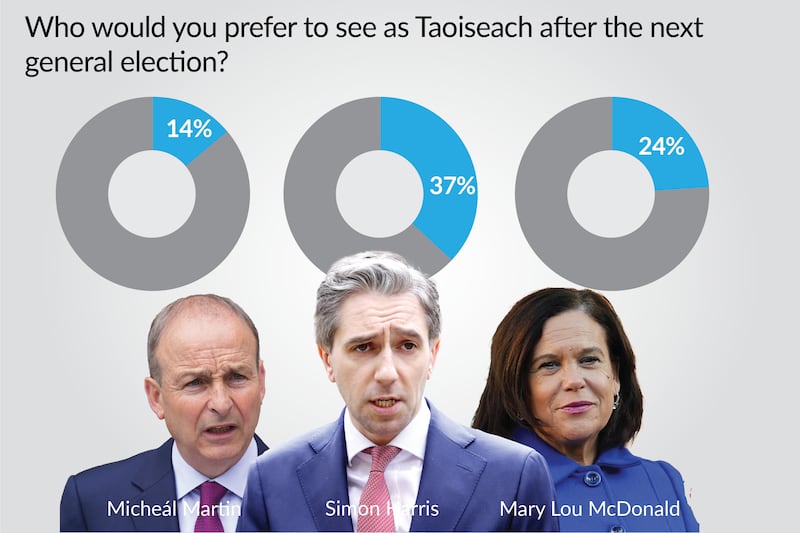Today’s Irish Times/Ipsos B&A poll reveals that almost four in 10 voters (37 per cent) would like to see Simon Harris as taoiseach after the next general election.
Mary-Lou McDonald is the second most popular candidate at 24 per cent, while Micheál Martin ranks in third position at 14 per cent. A further 15 per cent favour another option and 10 per cent did not express a preference.
Fieldwork for this poll was conducted between September 14th and 17th among a nationally representative sample of 1,200 voters aged 18 years and upwards.
All constituencies were sampled, with interviewing conducted in-home by Ipsos B&A interviewers. Percentages are reliable to within about 2.8 per cent in either direction.
READ MORE

That Harris is the most popular candidate should come as no great surprise following the Irish Times/Ipsos B&A poll results published on Thursday, which showed his satisfaction rating at 55 per cent – a 17-point increase since our last poll in May.
Harris enjoys broad support to be the next taoiseach, but it is not universal. Younger voters (aged 18 to 24) would prefer to see McDonald as taoiseach, with 36 per cent opting for the Sinn Féin leader and 26 per cent choosing the Fine Gael leader. Voters in the C2DE socioeconomic grouping – lower-income voters – are evenly split with 31 per cent opting for Harris and the same proportion choosing McDonald.
[ Simon Harris has the momentum but Sinn Féin’s slide continuesOpens in new window ]
The voters most likely to support Harris being the next taoiseach are those aged 65 and over, at 48 per cent, and those in Dublin, at 42 per cent.
As one would expect, the vast majority of Fine Gael (82 per cent) and Sinn Féin (81 per cent) voters would like to see their respective leaders become taoiseach.
However, it is striking that just 48 per cent of Fianna Fáil voters would like to see Micheál Martin as taoiseach, while 38 per cent favour Harris. Notably, only 3 per cent of Fianna Fáil voters would like to see McDonald elected as taoiseach.
Regardless of whether or not Harris goes on to lead the next government, decisions on its formation lie ahead. As part of our poll, potential coalition options were presented to voters. A Fianna Fáil-Fine Gael only coalition was the most popular choice among 22 per cent of voters, narrowly beating a continuation of the current Fianna Fáil-Fine Gael-Green coalition, which is supported by 21 per cent of voters.
A further 16 per cent would like to see a government led by Sinn Féin without either Fianna Fáil or Fine Gael, 7 per cent would like a Sinn Féin-Fianna Fáil coalition and 5 per cent would like a Sinn Féin-Fine Gael coalition, 14 per cent would like another combination and 15 per cent are undecided.
Both Fianna Fáil (48 per cent) and Fine Gael (47 per cent) voters would prefer their parties return to a coalition government consisting solely of the two parties. For both sets of voters this is preferable to continuing the current coalition with the Green Party, which garners the support of 29 per cent of Fianna Fáil voters and 34 per cent of Fine Gael voters.
Understandably, the majority of Green Party voters (67 per cent) would like to see the current arrangement remain in place. A similar proportion of Sinn Féin voters (66 per cent) would like to see a government led by their party without either Fianna Fáil or Fine Gael.
Before any coalition can be formed the votes must be cast. Today’s poll also provides an insight into the issues most likely to influence voter decisions in the next election.
- Listen to our Inside Politics Podcast for the latest analysis and chat
- Sign up for push alerts and have the best news, analysis and comment delivered directly to your phone
- Find The Irish Times on WhatsApp and stay up to date










